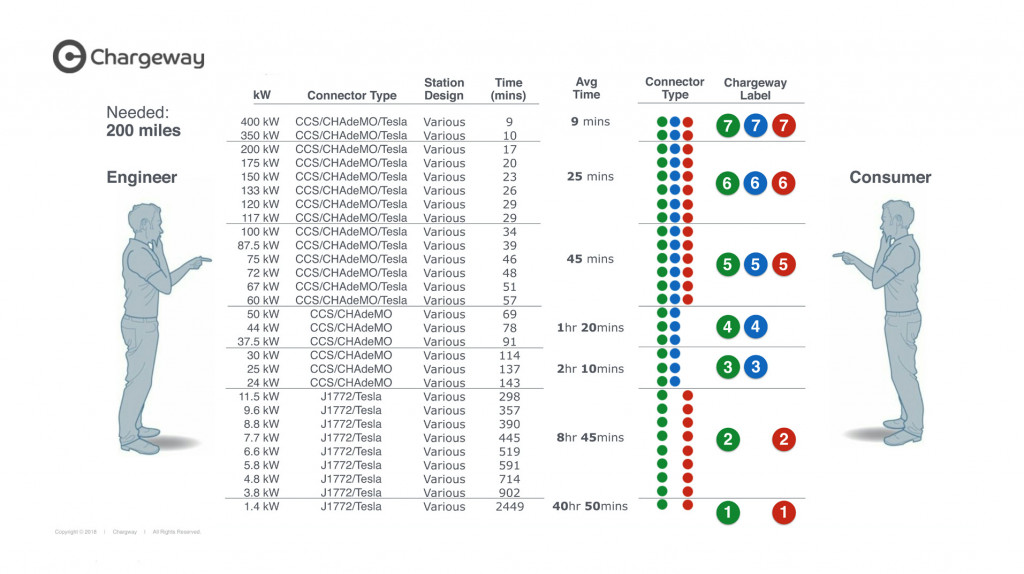Charging has been a key obstacle to electric carbuyers, and it may not just be the number of public stations available.
With three different "levels" of charging, and multiple charging speeds and connector types within each of those, it can be confusing for the average driver to know what type of chargers their car can use and what will give them the fastest charge their car can handle.
Now Chargeway, a Portland, Oregon, company, is planning to put up roadmaps with each charger along the city's two main highway corridors to help guide electric-car drivers through charging. The company has signed on with two Oregon utilities, car dealers, and a non-profit organization to promote the scheme.

Chargeway electr-car charging schematic
The directions are simple. Three colors correspond to the type of connector each car can take. Numbers printed on the colored dots denote charging wattage.
"Know your color. The higher the number, the faster you charge," are the simple instructions.
Green indicates a "standard" J1772 connector along with its CCS Combo fast-charge counterpart. (A car with a CCS fast-charge connector takes a standard J1772 plug for slower charges.)
Blue is for CHAdeMO DC fast charge connectors. (Cars that have a CHAdeMO fast-charge port also have a separate J1772 port for everyday charges.)
Red is only for Teslas, which use their own type of connector.
READ THIS: Chargeway: the best electric-car idea you've never heard of
Chargeway developed the schematic last year. Now it is working with local utilities, car-dealer groups, and non-profits in Portland to roll out its labels on local charging stations and offer them to electric car drivers in a pilot program later this year to see if drivers find it helpful. The labels will roll out this year, and Chargeway may deploy them on a broader scale next year.
"For most people, filling your gas tank is as easy as remembering one word: Regular," says Chargeway founder Matt Teske.
"The auto industry needs fresh tactics to help improve the electric car sales process and ownership experience," says Greg Remensperger, executive vice president of the Oregon Auto Dealers Association. "We believe Chargeway is the right solution to help align electric cars with mainstream buyers' needs and expectations."
In an effort to simplify, the labels leave a couple of holes. Cars equipped with CHAdeMO fast chargers will need to have two colors, because they have two separate plugs for standard AC charging and DC fast charging. The schematic also lays out many more levels of DC fast charging than it does for more common Level 2 charging, which can also vary greatly in charging speed.
Chargeway includes estimates of how many miles users will get in one hour of charging at its different numbered levels, from 3.5 to 10 miles per hour for a "1," 14 to 66 miles per hour on a "2," and 70-345 miles per hour on a "3." Number 7 seems likely to be reserved for trucks with charging speeds ranging from 700 up to almost 1,400 miles of range per hour—much longer than the range of any electric vehicle currently on the market.
Update: An earlier version of this story has been updated to reflect that Chargeway's pilot program is scheduled to roll out later this year. None of its signs are posted yet.












